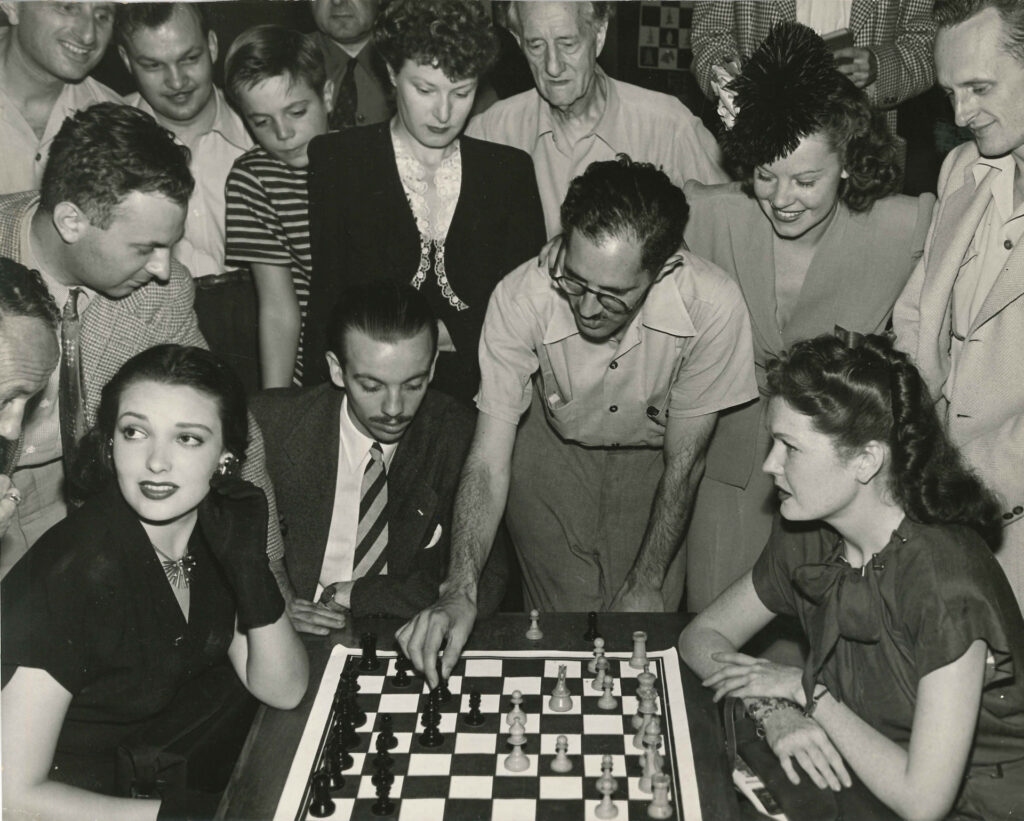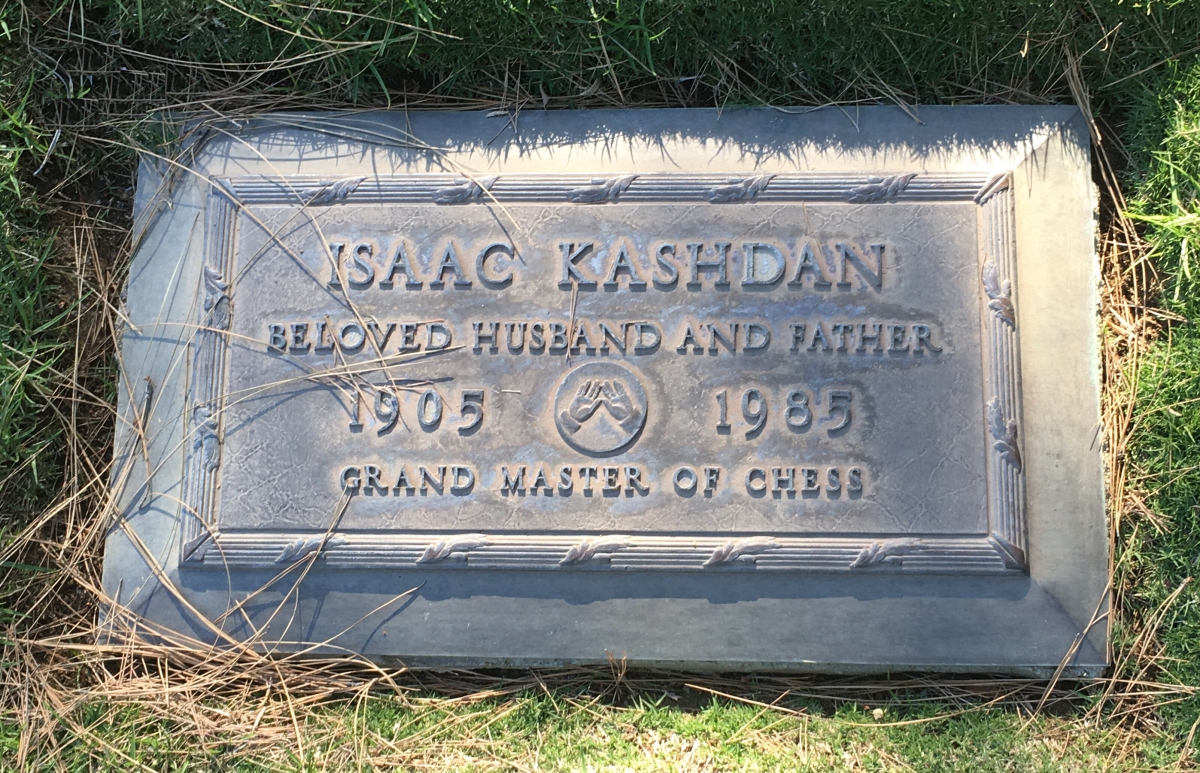Among the strong U.S. chess players who enjoyed success in the first half of the 20th century — that is, before the Second World War — the names best known outside the United States are Frank Marshall, Reuben Fine and Samuel Reshevsky. Isaac Kashdan is less widely known, although in the early 1930s he was among the very best players in the world. Jeff Sonas calculated a historical Elo rating of 2742 for Kashdan at his peak (in March 1932), placing him roughly on the same level as Alexander Alekhine and José Raúl Capablanca.
Isaac Kashdan was born on 19 November 1905 in New York into a Jewish family. Today marks the 120th anniversary of his birth.
Kashdan attended New York College and was a member of several New York chess clubs. At the Marshall Chess Club he quickly became one of the strongest players and won the club championship from 1929 to 1931.
Kashdan had already gained recognition beyond the city limits in 1924, when, at age 19, he won a problem-solving competition held on the sidelines of the famous New York tournament. Among others, he finished ahead of Richard Réti, who had also taken part.
Kashdan was selected for the U.S. national team at the 2nd Chess Olympiad, held in The Hague in 1928, and won the silver medal with the team behind Hungary. In 1930 the U.S. team finished sixth at the Chess Olympiad in Hamburg. At the Olympiads in Prague 1931, Folkestone 1933, Warsaw 1935 and Stockholm 1937 the U.S. team won gold each time, and — with the exception of the 1935 Olympiad in Warsaw — Kashdan was always part of the squad. In 1928 and 1937 Isaac Kashdan also won the individual gold medal on his board, and in 1933 the individual silver medal. In later years, Kashdan served as captain of the U.S. team (1928 to 1964).
The U.S. team on 31 July 1937 at the Chess Olympiad in Stockholm: from left: Fritz Brieger (captain), Sammy Reshevsky, Isaac Kashdan, Israel Albert Horowitz, Reuben Fine, Frank Marshall. | Photo: Svenska Dagbladet Archive via Douglas Griffin on X
Unlike some other top U.S. players, Kashdan did not dare to become a chess professional during the years of the economic depression; instead, he worked for an insurance company on Wall Street.
The early 1930s saw a series of international tournament successes. In 1930, Kashdan travelled through Europe, convincingly won a small four-player tournament in Berlin at Café Moka Efti — where Friedrich Sämisch also took part — finished second in Frankfurt in September behind Aaron Nimzowitsch, and won by a large margin a modestly-strong tournament in Győr (Hungary) as well as an event in Stockholm.
At the tournament in New York in April 1931, Kashdan had to yield first place to Capablanca and finished second. Because of the similarity of his playing style to Capablanca’s and his ability to convert even small advantages into victory, contemporaries called Kashdan the “Little Capablanca.”
After the Chess Olympiad in Prague in 1931, Kashdan competed in the strongly contested, double-round tournament in Bled. He shared fourth place behind the dominant Alexander Alekhine (20½/26), Efim Bogoljubov and Aaron Nimzowitsch, tying with players such as Vidmar. At the turn of the year 1931/32, Kashdan finished second at the Christmas Congress in Hastings, behind the rising star Salo Flohr.
Kashdan blieb in England und reiste im Februar 1932 nach London, wo er beim ebenfalls stark besetzten London Masters hinter Aljechin und Flohr zusammen mit Sultan Khan geteilter Dritter wurde.
Later in 1932, Kashdan played in tournaments in Pasadena and Mexico City with good success. In Mexico, he shared first place with Alekhine.
After that, Isaac Kashdan’s successful career took a downturn, and the number of tournaments he played in — especially abroad — decreased noticeably. Kashdan continued to represent the U.S. team at the Olympiads mentioned above and competed in U.S. national and regional championships. At the 1936 U.S. Championship he finished fifth. Samuel Reshevsky won the title.
As early as 1933, Kashdan had begun to work as a chess journalist and became co-editor of The Chess Review, founded by Albert Horowitz.

Kashdan and Horowitz, 1938
In the 1940s, the Second World War also overshadowed chess life, although it did not come to a complete standstill in the United States. At the 1940 U.S. Championship, Kashdan finished in third place. In 1942, Reshevsky and Kashdan shared first place; Reshevsky won the subsequent playoff. In both 1946 and 1948, Kashdan finished as runner-up.

Linda Darnell and Rosanne Murray play chess while Reuben Fine, Hector Rossetto, Mona May Karff, Hermann Helms and Isaac Kashdan look on at the opening of the Pan-American Tournament in 1945. | Photographer: Nancy Roos | Collection of the World Chess Hall of Fame, gift of the family of Jacqueline Piatigorsky

Hollywood Pan-American Tournament, 1945. Kashdan plays against Araiza. Collection of the World Chess Hall of Fame, gift of Richard Kashdan.
The following game from 1948 is considered Kashdan’s “Immortal”:
In 1949, Isaac Kashdan took on the role of Life Director in the U.S. Chess Federation. Kashdan also served as an arbiter (from 1960 onward) and as an organizer.
After Groucho Marx, the head of the famous Marx Brothers, ended his film career, he hosted a radio quiz show that was adapted for television under the title “You Bet Your Life.” The guests were “ordinary people” as well as celebrities, who appeared in pairs and had to answer questions together. In one episode, in 1956, Groucho welcomed Isaac Kashdan to the show. Kashdan’s fellow contestant was Helen Schwartz, the mother of Tony Curtis.
On the show, Groucho asked Kashdan about his profession and then challenged him to a game of chess.
Kashdan replied: “I’m free this evening and I’m giving a blindfold simul — you can join in.”
Groucho: “Why blindfold? Can’t you stand the sight of me?”
Kashdan: “I think I can beat you even blindfolded.”
Groucho: “But then you won’t see me cheat.”
Kashdan: “Chess is one of the few games where you can’t cheat.”
Groucho: “If I can’t cheat, forget it. That’s the only fun I have when playing.”
Kashdan served as arbiter at both Piatigorsky Cups, in 1963 and 1966, and organized, among other events, the Lone Pine tournaments sponsored by his friend Louis Statham as well as the 1961 match between Fischer and Reshevsky.
As a journalist and author, Isaac Kashdan wrote the chess column for the Los Angeles Times from 1955 to 1982 and edited tournament books on the 1933 Chess Olympiad and the Piatigorsky Cups.
Kashdan was married to his wife Helen for more than 50 years, and the couple had two sons. In 1982, Isaac Kashdan suffered a stroke, and he died from its effects on 20 February 1985.
He was buried in Mount Sinai Memorial Park (Hollywood Hills).

Photo: Brooke Schreier Ganz
Kashdan’s grave is located at “Canaan Map 4, Lot 858, Space 2.”
